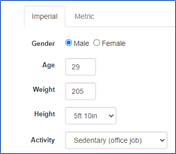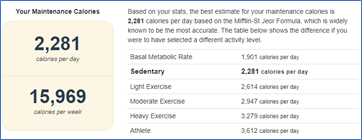Applying a Weight-Loss Equation to Busy Season
Working from home, 15 feet from the kitchen. An unrelenting tax season that makes eating right a challenge. When combined, unwanted weight gain can be a real danger for some CPAs. This blog contains the literal formula to help you shed pounds.
 By Robert S. Forney Jr., CPA
By Robert S. Forney Jr., CPA
In 2018 I was 26, had just obtained my CPA license, had a great job at a reputable CPA firm, was newly married, and weighed 255 pounds. Like many young professionals working in public accounting, I enjoyed the fancy dinners and open bars at firm functions, but I had gained close to 25 pounds over the course of two years because all I did was work and study.
In December of that year, I decided enough was enough: it was time to start prioritizing my health. Over the course of 2019, I made it my mission to lose weight, even if I was working busy season hours or traveling. After two weight loss cycles, I was down 50 pounds and shopping for new dress pants.
The process I used was simple, but by no means easy. I found the more I understood the science behind weight loss and nutrition, the better I could stick to my action plan. Here are a few tips and tricks from my own experience that could help you lose weight, even during busy season.
Disclaimer: The content of this article is not intended to be a substitute for professional medical advice, diagnosis, or treatment. Always seek the counsel of your physician or other qualified health provider with any questions you may have regarding a medical condition.
The Equation
Weight loss (or gain) can be boiled down to a simple formula:
Calories in – Calories out = Impact to weight
The goal is to eat fewer calories than you use on a daily basis; this results in weight loss. The two mysteries I first had to solve were:
- How many calories can I eat?
- How much should I exercise?
Before we answer those questions, let’s look at what constitutes a calorie. A calorie, by definition, is the amount of heat it takes to raise 1 kilogram of water by one degree Celsius.1 Our bodies take in macronutrients (macros) such as proteins, carbs, and fat and convert their calories into energy. The macros have different calorie densities: proteins and carbs have 4 calories per gram and fats have 9 calories per gram.2
To begin to figure out how many calories you should be eating, calculate your Basal Metabolic Rate (BMR), which is how many calories your body would burn if you were asleep (basically the base your body needs). I used the Total Daily Energy Expenditure Calculator at TDEECalculator.net to get a baseline. Simply type in your personal statistics and the calculator will display a table.


Based on my current statistics, my BMR is roughly 1,901 calories. From this, the calculator adds a few calories to factor in typical daily activities such as walking around the house, trips to the coffee maker, and household chores. This yields an estimation of your expenditure while working a sedentary job, i.e. an estimation of how many calories you would be able to consume on a regular basis while maintaining weight.
This brings us to the first question I posed above: how much should I be eating. A general rule of thumb is that that 1 pound of body fat equates to 3,500 calories.3 So, the answer to the quantity question all depends on the rate at which you wish to lose the weight. Nutritionists generally recommend not to lose more than 1 or 2 pounds per week.4 In my example, that would mean, at most, I should aim to lose 2 pounds per week. Because the minimum recommended number of calories you should be taking in is between 1,200 and 1,500,5 for most of my weight loss my goal was around 1,800 per day. This equated to a 500-calorie deficit, or roughly 1 pound per week.
(500 calorie deficit x 7 days = 3,500 calories, or roughly 1 pound)
Now I’ll turn to the topic of exercise. During busy season, many accountants are tied to their desks 10 to 12 hours per day. Layering in family obligations, there aren’t many hours left for exercise to raise your energy expenditure. Don’t be discouraged: I’d like to emphasize that it is possible to lose weight without exercise. The only downside to this option is you MUST be mindful of and adherent to your caloric intake. The process is less forgiving if you don’t have the option of going for a 30-minute run.
In an ideal world, we would all make time to exercise, but there’s a saying: “You can’t out work a bad diet.” A 2007 study in the journal Obesity looked at the physiological impact on a group of sedentary individuals of doing 60 minutes of exercise, 6 days a week, for a year.6 The group that exercised lost weight, but not enough (in my personal opinion) to warrant the extra work: male participants lost roughly 4 pounds and female participants lost roughly 3 pounds.
From my own experience, I lost my first 20 pounds from December 2018 to May 2019 while working 50-plus hours per week. I didn’t have time to exercise in any consistent or meaningful way because of client work and travel.
The Application
Now is a great time to try to lose weight. The current work-from-home environment gives us a unique opportunity to not have to rely so much on keeping track of the Tupperware while traveling to and from the office. Here are a few ways to implement what has been outlined above:
- Before you start changing your diet, investigate what you’re currently consuming and highlight potential first steps.
- Download a calorie tracker like My Fitness Pal. Many have useful features such as barcode scanners or restaurant databases.
- Start with simple substitutions: swapping sodas for seltzers, fried chips for baked options, and sauces for spice blends (seasonings are your friend!).
- Look for easy wins. After you start tracking your diet by using an app or by another means, some easy wins can be avoiding alcohol for the time being and opting for lower-calorie snacks. Easy wins at the beginning can be motivating.
- Don’t dwell on setbacks. Lapses in judgement, a birthday dinner, or an occasional dessert are not signs of defeat. Similarly, weight can fluctuate due to other health reasons such as sleep deprivation and hormonal imbalance.
- Change one meal at a time. On one of my attempts to lose weight, I changed everything all at once. I was eating string cheese and half a piece of toast, wondering why I was doing this to myself. Then, I started to focus on one meal at a time. I started by making better choices at breakfast. I went from chicken biscuits to oatmeal with peanut butter or frozen berries. Then I started packing healthier lunches, going from mayo-and-dressing-laden 600-calorie chicken wraps with fries to seasoned beans and rice. Then I swapped the snacks of pretzels for protein bars and fruit. Starting something new can be exciting, but it’s often best to wade into the water instead of diving straight in.
- Raise the amount of protein you consume. Studies show that not only is protein the most satiating of the three macronutrients,7 but it can also aide in the mitigation of muscle loss during times of caloric deficit.
- Dominate your meals with foods with low-caloric density. I would bolster a single serving of pasta with an entire bag of frozen steamed broccoli. I was more likely to stop eating from a feeling of fullness than from an external, forced adherence to a calorie goal.
- Track the hidden calories. If you made eggs, did you use butter? Was your stir-fry cooked using olive oil? Did you put barbeque sauce on your chicken?
- Don’t fall for fads. There are many diet fads out there, but if you stick to the basic equation presented in my opening, you aren’t far away from improving your health.
- Consistency is more important than perfection. An 80/20 rule can easily be applied to your journey. The better the adherence to your calorie count, the better results you will have, but that doesn’t mean you need 100% adherence to make progress. A pound lost is a pound closer to your goal.
 Dieting isn’t easy; in fact, it can be intimidating. But these simple tips and tricks do help. When I started looking to drop weight, I created an Instagram to find and build a fitness community. As I progressed in my journey, I began running and documenting the miles and added diet tips on my Instagram page. Feel free to check it out. Right now, I’m about 20 pounds from my goal weight and am training for a 50k this summer. I am not at my goal yet, but I am getting there one step at a time.
Dieting isn’t easy; in fact, it can be intimidating. But these simple tips and tricks do help. When I started looking to drop weight, I created an Instagram to find and build a fitness community. As I progressed in my journey, I began running and documenting the miles and added diet tips on my Instagram page. Feel free to check it out. Right now, I’m about 20 pounds from my goal weight and am training for a 50k this summer. I am not at my goal yet, but I am getting there one step at a time.
1 https://www.nutrition.gov/expert-q-a
2 https://www.nal.usda.gov/fnic/how-many-calories-are-one-gram-fat-carbohydrate-or-protein#:~:text=Nutrition%20Education%20Materials-,How%20many%20calories%20are%20in%20one%20gram%20of%20fat%2C%20carbohydrate,provides%209%20calories%20per%20gram
3 https://www.healthline.com/nutrition/calories-in-a-pound-of-fat#TOC_TITLE_HDR_3
4 https://www.mayoclinic.org/healthy-lifestyle/weight-loss/in-depth/weight-loss/art-20047752#:~:text=Over%20the%20long%20term%2C%20it's,diet%20and%20regular%20physical%20activity
5 https://www.openfit.com/whats-the-minimum-calorie-intake-you-should-consume-when-dieting
6 A. McTiernan, B. Sorensen, M. L. Irwin, A. Morgan, Y. Yasui, R.E. Rudolph, C. Surawicz, J.W. Lampe, P.D. Lampe, K. Ayub, J.D. Potter, “Exercise effect on weight and body fat in men and women,” Obesity (2007 June) 15(6):1496-512. https://doi.org/10.1038/oby.2007.178
7 Douglas Paddon-Jones, Eric Westman, Richard D. Mattes, Robert R. Wolfe, Arne Astrup, Margriet Westerterp-Plantenga, “Protein, weight management, and satiety,” The American Journal of Clinical Nutrition, Vol. 87, Issue 5 (May 2008), pages 1558S–1561S. https://doi.org/10.1093/ajcn/87.5.1558S
Robert S. Forney Jr., CPA, is an internal auditor in the Philadelphia banking industry and competed in the 2020 Spartan Virtual Trifecta World Championships. He is also a member of the Pennsylvania CPA Journal Editorial Board and can be reached at rob.forney.cpa@gmail.com.
Sign up for weekly professional and technical updates from PICPA's blogs, podcasts, and discussion board topics by completing this form.
PICPA Staff Contributors
Disclaimer
Statements of fact and opinion are the authors’ responsibility alone and do not imply an opinion on the part of PICPA officers or members. The information contained in herein does not constitute accounting, legal, or professional advice. For professional advice, please engage or consult a qualified professional.






